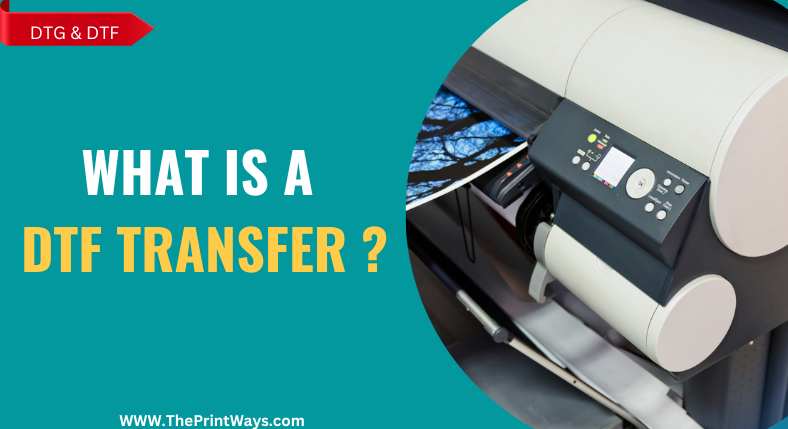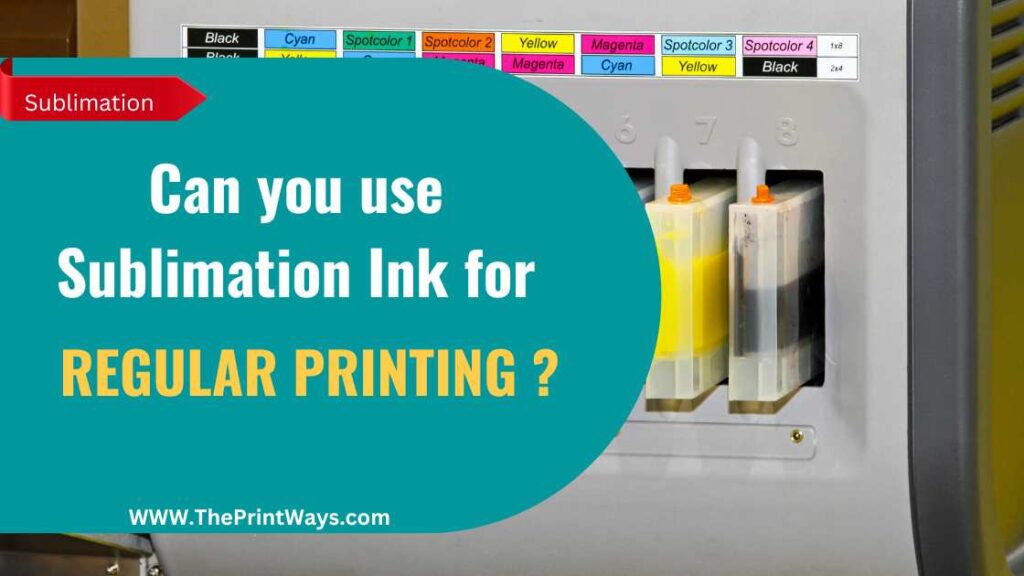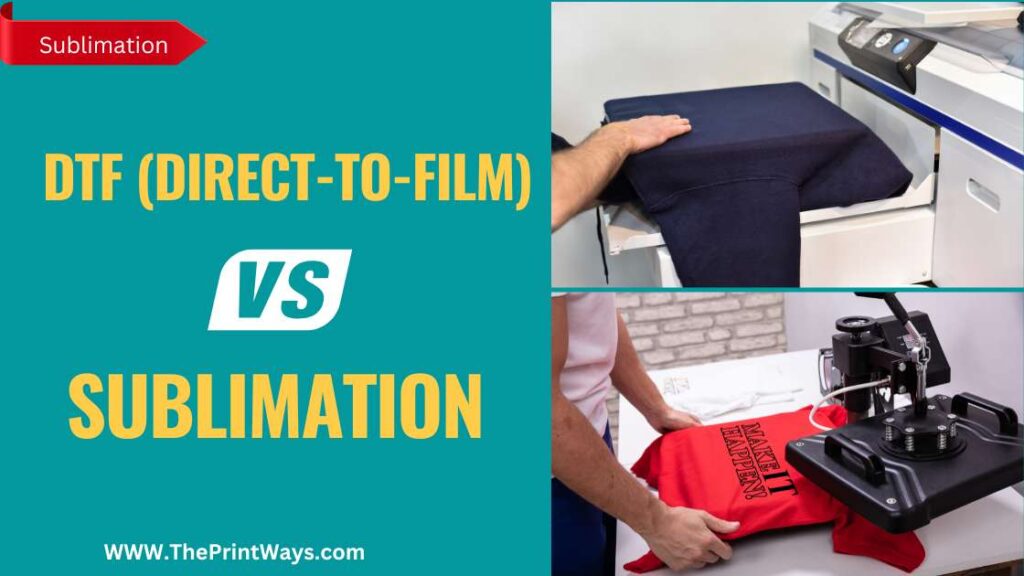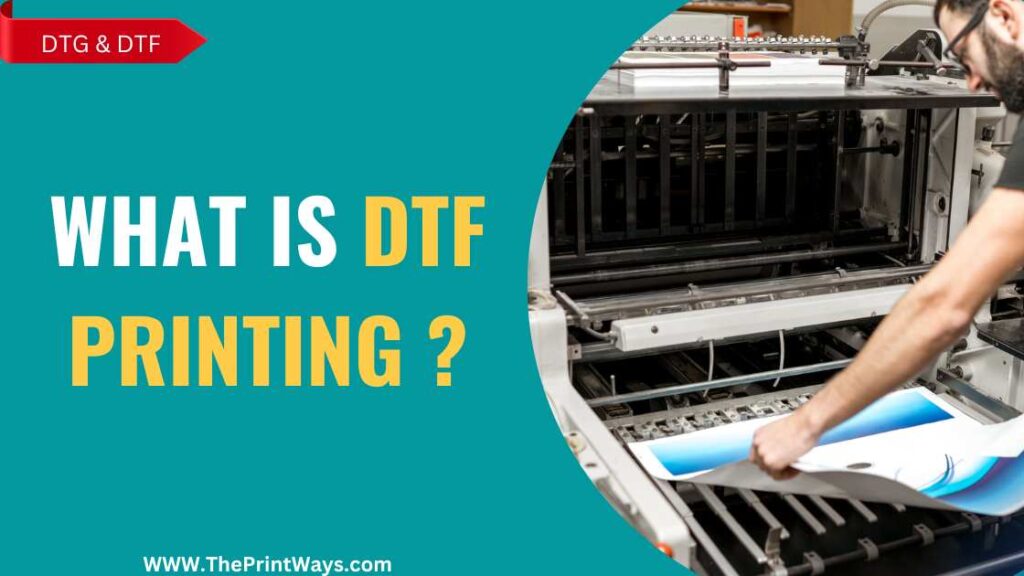As an alternative to more conventional printing techniques like screen printing and DTG printing, direct to film (DTF) transfer printing has seen rapid growth in recent years. Printing a design onto a DTF transfer film sheet and then applying heat with a transfer press yields a DTF transfer.
The process’s ability to produce prints with vivid colors and precise details makes it a desirable choice for companies and people manufacturing personalized clothing, promotional items, and other items.
What Is A Dtf Transfer?
Like DTG (direct-to-garment) printing, DTF transfer is a printing method used to transfer designs onto fabrics. When a pattern is printed onto a specific film using a printer and ink made for that purpose, the film is then transferred to the fabric using heat and pressure; this technique is known as a “direct-to-film” transfer, or DTF.
DTF printing makes use of a unique vinyl film with an adhesive layer triggered by heat, which attaches to the fabric during the transfer process. Full-color graphics on cotton, polyester, or blended fabrics are frequently printed using DTF printing. Because it’s possible to print with vivid colors and intricate details, this method has found widespread use in the custom clothing market.
How to make DTF transfers ?
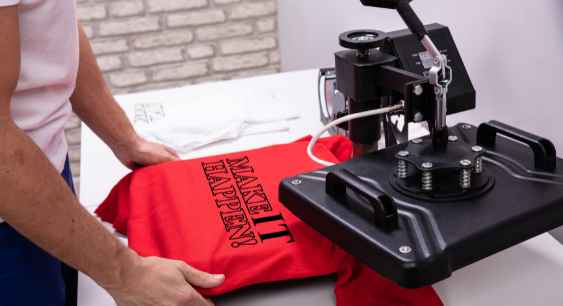
The printing technology known as DTF (Direct-to-Film) transfers is commonly used in the garment printing industry to transfer graphics onto fabrics. The high-quality prints with sharp details and vivid colors produced by this method are contributing to their rising popularity. To make a DTF transfer, do the following:
- First, you’ll need a design, which you can develop in a piece of graphic design software or download from the internet. Verify that the layout can be printed using DTF technology.
- Use DTF ink to print the design onto DTF film by loading the film into a compatible printer. DTF ink’s sticky characteristics make it ideal for transferring designs to textiles.
- Adhesive powder should be applied to the printed surface after the design has been produced. The inked portions of the design are where the adhesive powder will attach to the fabric during the transfer process.
- Powder curing entails utilizing a heated curing equipment to set the powder’s design and adhesive properties. The glue will become active and adhere to the fabric during the transfer process.
- After the adhesive has dried, lay the design, adhesive side down, on the fabric. Put the fabric in a heat press machine and use heat and pressure to transfer the design. The quality of the transfer is guaranteed by the equal distribution of heat applied by the heat press machine.
- Carefully removing the DTF film reveals the transferred design on the cloth after the transfer procedure is complete.
- In order to permanently adhere the transferred design to the fabric, it must be cured. Put the design through a heat press or dry it on a belt dryer. In order to prevent the fabric or pattern from being ruined, this process must be carried out under strictly regulated conditions.
- Once the garment has cured, it can be worn or sold. The pattern will look great and last a long time, and the fabric will be nice and cozy even after repeated wear.
Also Read: What can DTG Printers print on ?
Types Of Films Suitable For Dtf Transfer
The printer and ink combination, as well as the intended purpose of the film, will determine which films are most suited for DTF transfer. However, the following films are frequently used for DTF transfer:
Polyester Film: Polyester films are often used for direct-to-film printing because they are long-lasting and provide superb ink adherence.
Mylar Films: Known for its durability and consistency in size, Mylar films are a type of polyester film.
Acetate Films: Films made of acetate are also frequently used for DTF printing. They’re see-through, bendable, and have excellent ink adherence.
Vinyl Films: When a more malleable substrate is needed, like for printing on clothes, DTF printing is performed on vinyl films.
Photographic Films: For high-end DTF printing applications like fine art reproductions, photographers turn to photographic films.
Tips To Improve The Quality Of A Dtf Transfer
Direct to film (DTF) transfers are an efficient way of transferring images or artwork onto a medium such as paper, cardstock, fabrics and more. For those looking to get the most out of their DTF transfer, here’s some tips on how to improve its quality.
1) First and foremost, it is important that your artwork is properly prepared before being transferred. This means ensuring that all lines are crisp and clear with no smudging or fading.
2) If possible, use vector software rather than raster graphics so that you can maintain the highest level of detail during transfer.
3) Additionally, when setting up your image for print, make sure to adjust your resolution settings accordingly; this will help ensure that you get a good quality result after printing.
4) It’s also essential that you use high-quality materials for your DTF transfer project. Make sure to select inks and films which are designed specifically for this purpose.
5) Furthermore, take care when handling any exposed surfaces – as even small marks can affect overall results significantly once printed!
How To Remove Dtf From Shirt ?
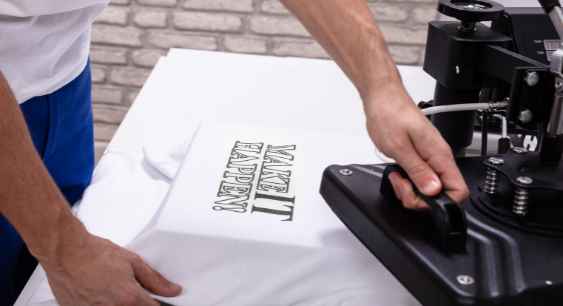
DTF (Direct to Film) printing is a technology for producing high-quality prints on fabric. However, the DTF ink can sometimes transfer to other surfaces, such as your shirt. Here are some methods for getting DTF ink out of your shirt:
1) Rubbing Alcohol:
Rubbing alcohol is one approach. Use rubbing alcohol to dampen a clean cloth or sponge and blot the spot. Rub the ink off using the cloth. Keep doing it until the stain is gone and then wash the shirt.
2) Dish Soap:
Dish soap works too. Mix a few drops of dish soap with water to make a soapy solution, then dip a clean towel into it and wring it out. Blot the soiled area with the soaked cloth and gently rub until the ink comes off. Repeat until stain is gone and then wash the shirt as usual.
3) Vinegar:
Vinegar works too. Mix equal parts white vinegar and water and dampen a clean towel. Blot the soiled area with the soaked cloth and gently rub until the ink comes off. Repeat until stain is gone, then wash shirt as usual.
4) Stain Remover:
Using a stain remover may help. Apply a small amount of stain remover straight to the affected area, let it sit for a few minutes, and then gently massage the area with a clean cloth until the ink comes off. Repeat until stain is gone, then wash shirt as usual.
5) Baking Soda:
Finally, use baking soda. Apply a paste made from a few teaspoons of baking soda and adequate water to the stain. Rub the ink off using a clean cloth. Repeat until stain is gone, then wash shirt as usual.
Related: How to Remove Logo from Shirt ? (8 Best Methods)
DTF Vs Heat Transfer : Comparison
In order to transfer designs onto different substrates, common techniques include DTF (Direct to Film) printing and Heat Transfer. Different applications of DTF and Heat Transfer are compared below.
Print Quality:
The print quality of DTF printing is typically superior to that of heat transfer. Since DTF prints directly onto the film, the resulting images have higher color saturation, sharper lines, and clearer details.
Durability:
DTF and heat transfer both generate long-lasting prints, although DTF is the standard in this regard. DTF transfers outperform heat transfer prints in high-wear situations like sportswear because they can endure more washings and abrasion.
Cost:
Compared to direct-to-flat (DTF) printing, heat transfer is typically more cost-effective. Now that heat transfer printers are more common and inexpensive, they can be used by a wider range of enterprises and individuals.
Ease of Use:
Heat transfer is more user-friendly than direct-to-fabric (DTF) printing. Heat transfer is easier for novices or those with little experience to perform because it requires less preparation time and equipment.
Related: DTF Vs Sublimation: Which is Better ?
Versatility:
DTF and heat transfer are both versatile in that they can be applied to many different materials, from textiles to plastics to metals. DTF printing, on the other hand, can print on heavier surfaces like wood or glass, something that heat transfer cannot do.
Sustainability:
When compared to heat transfer printing, DTF printing is more sustainable. DTF eliminates the need for transfer paper and glue, hence decreasing waste and eliminating the exposure to potentially hazardous chemicals.
Time Efficiency:
Heat transfer is typically quicker than DTF printing when it comes to turnaround time. It only takes a few seconds to apply a heat transfer print, but DTF printing takes a while to print and transfer the design to the substrate.
Check out this Tutorial:
Frequently Asked Questions
Q: What kind of printer do I need for DTF printing?
For direct-to-film printing, you’ll need a dedicated printer. Epson SureColor P800, P600, L1800, and L1300 are just a few examples of well-liked DTF printers.
Q: Can DTF printing be done at home?
With the right tools (a DTF printer, DTF film, and a heat press), direct-to-film(DTF) printing can be done at home. However, mastery of the process and success in accomplishing your goals may require some time and effort on your part.
Q: How to Press DTF transfers?
A heat press is required for applying DTF transfers to a substrate. Follow the transfer manufacturer’s recommended settings for time, temperature, and pressure. Heat press the transfer onto the substrate for the specified amount of time.
Q: How long do DTF transfers last?
DTF transfers are long-lasting and can keep looking great through numerous washing. The transfer’s durability will be determined by a number of elements, including its quality, the substrate it is applied to, and the care it receives. In most cases, DTF transfers can continue for a few years.
Conclusion
In conclusion, DTF Transfer is an effective way to customize clothing items at home. It can be done quickly and easily with great results that will last for a long time. The cost of making a transfer isn’t too high either, which makes it even more attractive as an option. Plus you can use almost any color so your creativity won’t be limited in the least bit. You’ll also find the transfers are waterproof, ensuring they don’t fade or run when exposed to water or sweat.

